Forgotten Weapons is one of the most popular YouTube channels in the gun world, and for good reason. There is no better video source for gun history than Ian McCollum (which is probably why his fans refer to him as “Gun Jesus”). If you’re a historical firearms history buff, (or even if you’re not) you’re likely to enjoy learning about them with Ian as he shares his wealth of knowledge and familiarity with firearms most of us have never seen or heard of before.

What follows is a collection of articles covering Ian McCollum’s “Pistols of the Warlords” video series. Get yer history on and take a look at these pistols from Chinese history.
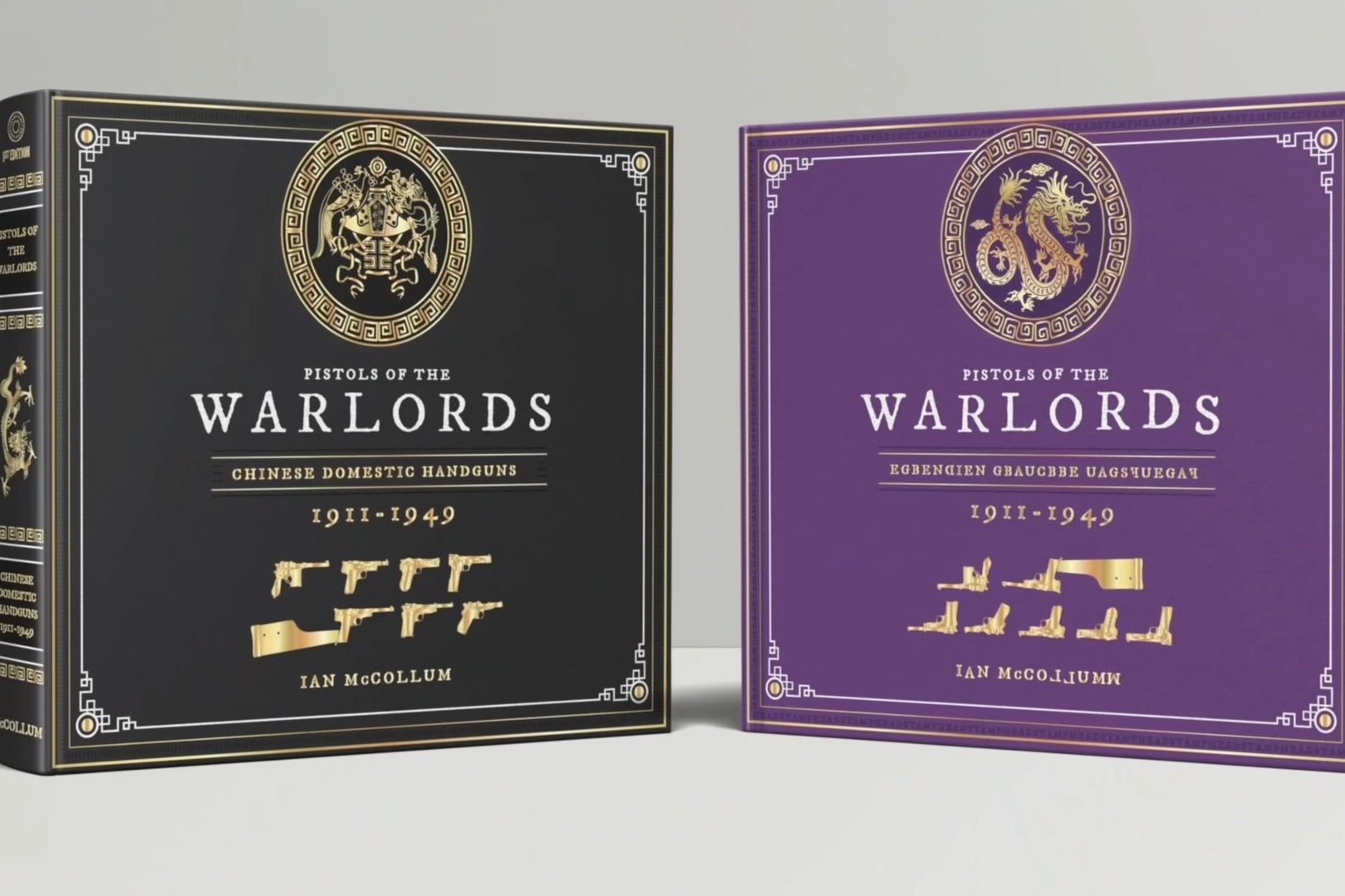
- John Browning in China? The Chinese Warlords’ Shanghai Arsenal Model 1900 Pistol Carbine
- Chinese Warlord Pistols: Shanghai Model 1900 Pistol Carbine
- Forgotten Weapons: Chinese Mystery Pistols
- NEW: “Pistols of the Warlords” by Ian McCollum
John Browning in China? The Chinese Warlords’ Shanghai Arsenal Model 1900 Pistol Carbine
William Lawson (September 2021)
Ian McCollum is back with another example of why he is one of the leading firearms experts on the planet. What I love about Ian is how he shows intimate familiarity with guns most of us have never heard of. This is no exception. While I literally could not name a single Chinese-made pistol, Ian has favorites. One of his favorites is the subject of this video: the Shanghai Arsenal Model 1900 Pistol Carbine. Basically, it’s a scaled-up version of John Moses Browning’s FN Model of 1900.

FN model of 1900. (R) Note the low-slung barrel underneath the recoil spring tube.
The FN 1900 was one of the two most popular pistol designs in China at the time, along with the C96 Broomhandle Mauser. Ian notes that the FN 1900 was really the first practical civilian semiautomatic carry pistol.
Shanghai Arsenal was set up on the Western model, with modern manufacturing processes, by the relatively stable national government which existed before the Warlord Era “descended into total chaos” after 1916. Prior to this descent, Shanghai had been producing exact copies of the FN 1900 and had just begun the manufacture of the larger scale pistol carbine, which was done, essentially, to mimic the C96 Mauser, complete with the capability to attach a stock, hence the “carbine.”
Chinese Warlords’ Shanghai Arsenal Model 1900 Pistol Carbine
The pistol carbine version was mostly the same as the 1900 Pistol. The differences were:
- The carbine’s 5.5” barrel, as opposed to the 4” pistol barrel.
- A longer slide and recoil spring to match the barrel.
- The addition of tangent rear sights.
- The ability to attach a stock.
The operating system was the same and they were both chambered in .32 ACP, just like the FN. Like the FN, the pistol carbine’s barrel is below the recoil spring tube, giving it a very low bore axis. The tangent sight is adjustable to a very optimistic 500 meters with a simple rear V-notch and front blade.

The rear of the grip is cut to allow the stock to be attached but the stocks themselves are so rare that even Ian hasn’t ever seen one. He speculates that they would be similar to the C96, which double as stock and holster.
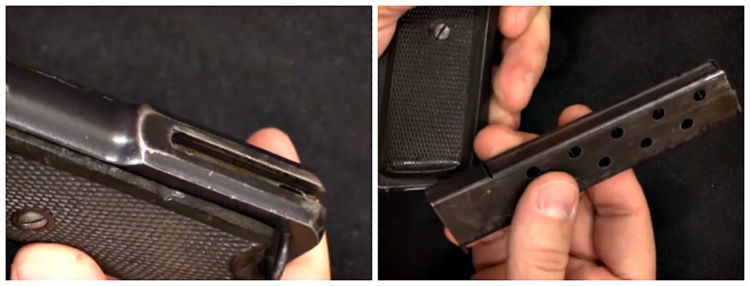
There is a frame-mounted safety lever on the left side, the mag release is in the heel, which was standard for the day, and the molded grips feature Chinese characters denoting the Shanghai Arsenal and date of manufacture.
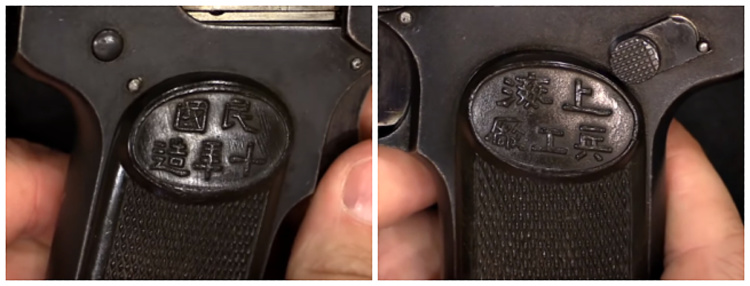
manufacture.
The guns are serialized, but there is some confusion about whether the pistol carbines had their own serialization or whether they were lumped in with the regular 1900 pistols. So, it’s unclear how many were actually made, but, either way, there were no more than about 4,300.

Takedown requires the removal of two screws near the rear of the slide which allows the removal of the slide to expose the recoil spring and breech block. The breech block is then removed, which Ian demonstrates. As he does so, he notes that the 1900, and the operationally identical pistol carbine, is “really a very clever little pistol.”


The Shanghai pistol carbines, as well as the Model 1900 pistols, are high-quality weapons, and the parts were designed to be interchangeable, though Ian notes that they might require a bit of hand-fitting given the manufacturing limitations of the time.
How to Identify a Shanghai Arsenal Model 1900 Pistol Carbine Knockoff
We then move to the interesting notion of a “Chinese knockoff of a Chinese design.” It’s a pistol carbine of the same basic design, but it’s clearly not arsenal-made. Here’s how you can tell the difference if you happen to run across one of these (photos provided):
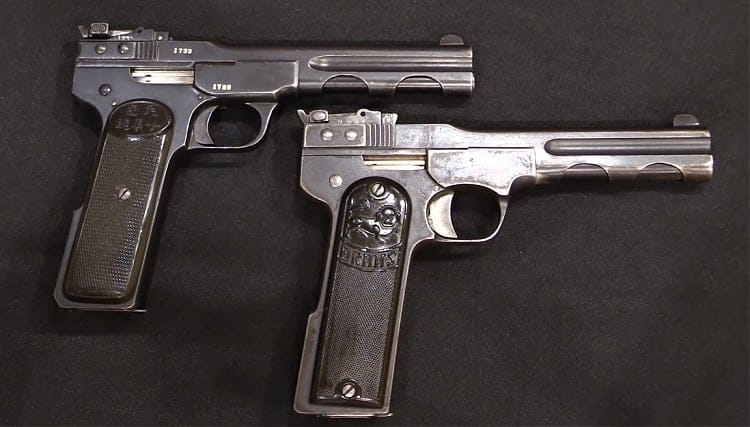
- The left side may feature long strings of gibberish markings. Ian says these markings are expected on “stereotypical artisanal production Chinese pistols.
- The grips are molded with backward, nonsensical letters and pictures of strange animals.
- There is a serial number, but it looks shoddy compared to the real thing. Ian says that “It is almost certainly not indicative of actual serial production of this pattern.”
- The bottom of the frame is wider and blockier than the real thing.
- The mags are different and crude, especially the floorplate.
- The trigger guard is milled differently.
- The rear sight is crude and mostly non-functional. The V-notch may be all but imperceptible.
- All in all, “this isn’t quite the same, in any area, as a real Shanghai 1900 Pistol Carbine. In general, just a lower standard of manufacture on the copy.”

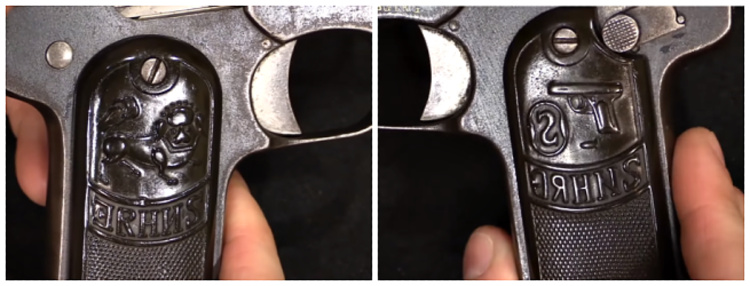

Now, I have to say that I wasn’t all that interested in an old Chinese Warlords pistol when I sat down to watch the video and write this article. But…as Ian went through it, I have to say that I thought it was pretty cool—certainly unique. As far as the quality of the Real McCoy, Ian says he plans to use it in an upcoming backup gun competition to see how it fares. As a lover of old surplus firearms, I can dig that.
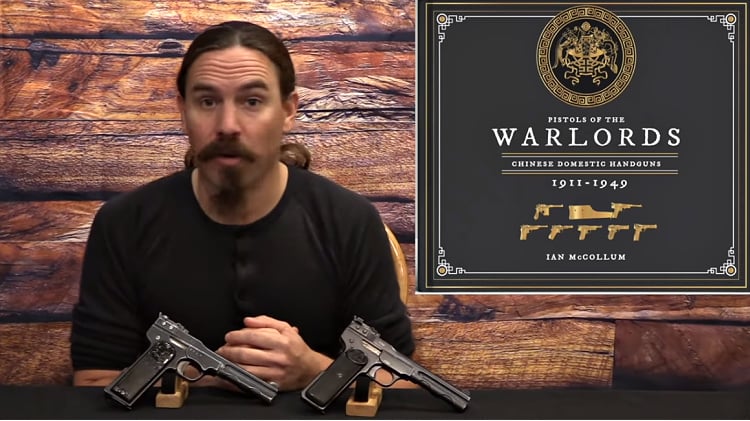
Chinese Warlord Pistols: Shanghai Model 1900 Pistol Carbine
Kat Ainsworth (July 2021)
There is simply no one like Ian McCollum of Forgotten Weapons when it comes to gun history. It doesn’t even matter if you’re a history buff or not; odds are you’re going to enjoy learning about guns from Forgotten Weapons. In this video, Ian McCollum gives viewers a better look at Chinese warlord pistols, specifically the Shanghai Model 1900 Pistol carbine. Yes, we said pistol carbine. Read on to learn more.
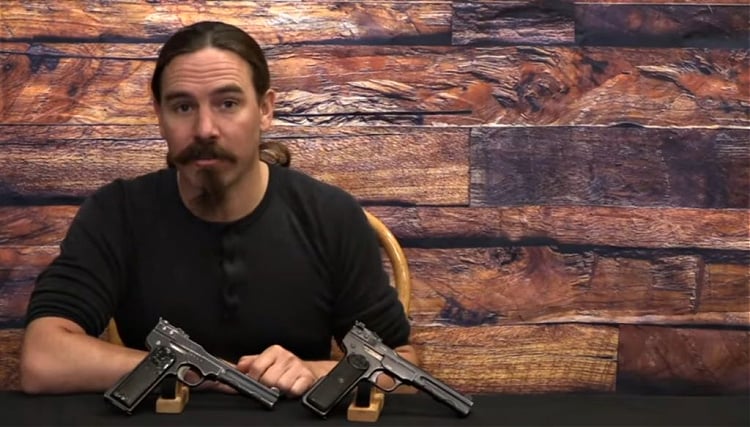
A Little History
From Ian McCollum on the basic history of these two pistols:
“This is a scaled-up — like a pistol-carbine version — of the FN Model of 1900. And these were manufactured at the Shanghai Arsenal in China between 1916 and 1921. …what we have here are the…FN 1900 was a particularly popular pistol in China, one of the two most popular pistol designs — that and the Broomhandle Mauser. …the Shanghai Arsenal, which, by the way, was set up basically along Western Industrial lines under a relatively stable government before the warlord era really descended into total chaos, this arsenal produced standard, actual exact copies of the FN 1900 and this sort of large-scale pistol-carbine version.”
Take a look at the video to learn more about these pistols:
Unique Features
One interesting feature of these pistols is the use of tangent sights. They look like the adjustable irons you often see on bolt-actions today, but a century ago they were often used on pistols. A tangent sight is an iron that is height-adjustable, a bit like a ladder, to adjust the rear sight to accommodate shots out to various yards (500 yards in this case, which is definitely a stretch for its 32 ACP chambering).

From FirearmsHistory.blogspot:
“The part to pay most attention to is the sight leaf, which is graduated and has a V-shaped notch on the plate in the rear of the sight leaf. This V-notch is the rear sight through which the user aims the weapon. Also pay attention to the ramp and the pivot ear in the diagram above. …the numbers 1-10 indicate the desired range in hundreds of meters. If the slider is set at 1, this is for ranges between 0-100 meters, if set at 10, this is for ranges between 900 and 1000 meters.”
Now, not all tangent sights are made the same, as you can see in the above image from Forgotten Weapons. As mentioned before, the Shanghai Model 1900 pistol is designed with numbers marking out to 500 yards.

The Wrap-Up
This is a fascinating look at two pistols that were apparently quite popular in China in the early 20th century. This should come as no surprise given the popularity of the FN 1900 itself, but it is interesting to see the pistol-carbine style of one of the guns McCollum talks about.
Do you think these guns would be better served in a modern model chambered in a different caliber, or is 32 ACP a perfectly capable round? Drop your thoughts in the comments section below.
Forgotten Weapons: Chinese Mystery Pistols
Kat Ainsworth (July 2021)
Getting a closer look at historical handguns is fascinating because not only does it give you a look into where modern-day guns came from, it lets you know what our ancestors had to work with. In many ways, technology has gone through leaps and bounds of growth, and in others it has retained its original form (with some new flourishes). In this video, Ian McCollum talks about the history of a selection of Chinese mystery pistols.
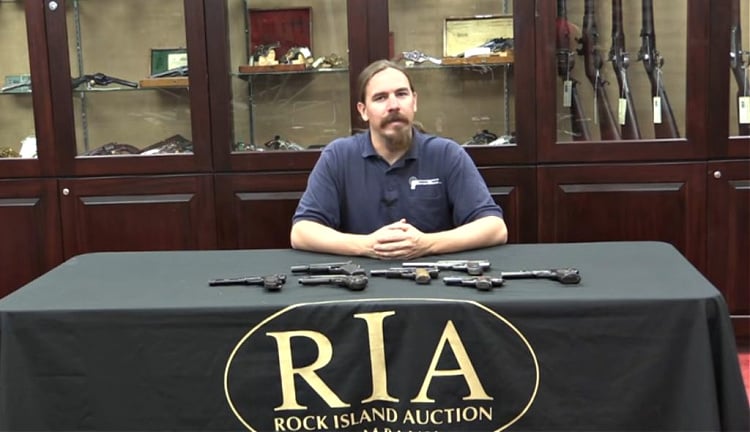
From Forgotten Weapons:
During the 1920s and 1930s, a combination of civil wars and international arms embargoes led to a lot of domestic firearms production in China. The size and quality of manufacturing facilities varied widely — everything from massive factories established with European technical assistance to one-man shops only a step or two above being blacksmiths. The weapons produced varied in quality to match.
Among other weapons made during this period were handguns mechanically based on several European designs (the Browning 1900, Mauser C96, and Mauser 1910/14, primarily). These handguns show a huge variety of aesthetic designs, gibberish markings, and fake proof marks. They are virtually all single action, simple blowback designs, chambered for .32ACP or 7.63 Mauser.
Why 32 Auto?
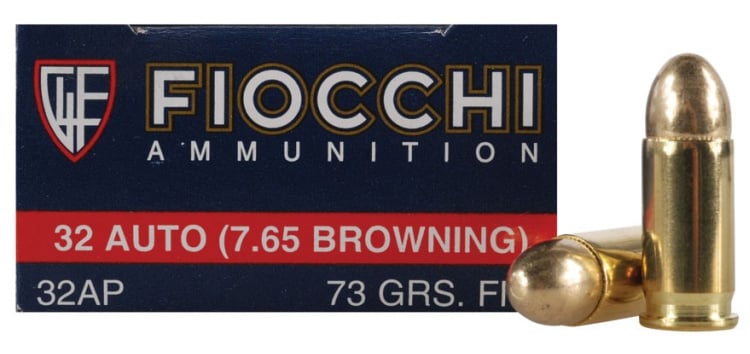
Apparently, a popular chambering in these pistols is the 32 Auto, known more commonly today as 32 ACP. Although today’s advances in ballistics have made the 32 ACP more of a fun round than a useful one, you can find modern handguns chambered in it.
The 32 ACP was designed by none other than John Browning and entered production in 1899. It was originally made for blowback semi-automatic pistols and has a rather interesting history when it comes to use. According to some historians, Adolf Hitler committed suicide with a Walther PPK chambered in 32 ACP, and Heckler and Koch’s first handgun, the HK 4, was also chambered in this diminutive round (that was back in 1967).
This round still has its uses, so if you’re interested in expanding your handgun experience, try one chambered in 32 ACP.
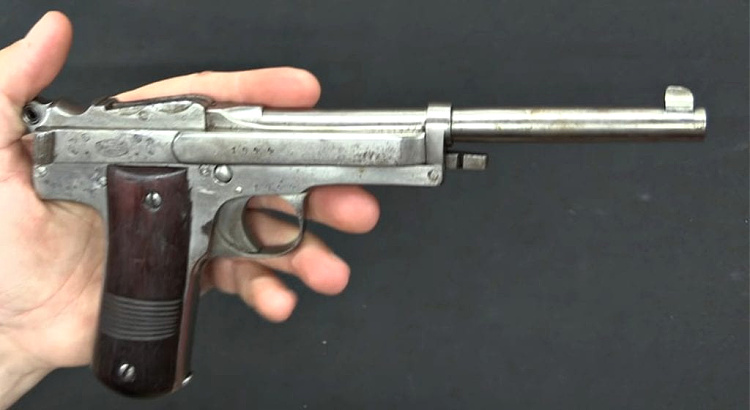
Interesting Chinese Mystery Pistol Details
There are some unique design features on these guns including one being made for use with a shoulder stock — something Ian says was common due to shipping and embargo problems with rifles at that time — and another chambered in 7.63 Mauser.
Another interesting element Ian talks about in the video is the fact that what appears to be complete nonsense stamped into the frames and slides of these guns is most likely on par with the way many people will tattoo foreign words they cannot actually read onto their bodies. Basically, the Chinese gunsmiths had a set of English stamps and used them to approximate the look of what would have been, at that time, a modern pistol.

Why Does History Matter?
Aside from the usual response that history repeats itself — and it really does, because manufacturers try to replicate old guns on a regular basis — gun history is just fun. Learning about the steps that have been taken along the way can be both enjoyable and informative, and I highly recommend following Ian McCollum’s Forgotten Weapons YouTube channel.
NEW: “Pistols of the Warlords” by Ian McCollum
Kat Ainsworth (July 2021)
In his latest venture, Ian is putting out a second book, “Pistols of the Warlords”. This book about the handguns that Chinese warlords used turned out to be over 500 pages. In order to get it out on the market, Ian has a Kickstarter campaign going.
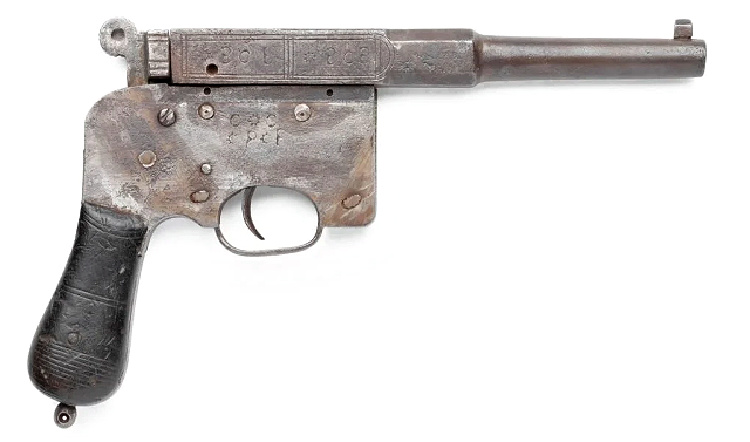
History Matters
If you’re wondering why you might want to know handgun history, there are several reasons:
- Understanding how technology advanced
- Knowledge of how different guns work
- Enjoyment of watching the evolution of handguns
- Shows you how certain factions worked
- Gives you a cool look at warlord life
- Identifies guns you might not otherwise recognize
- You see how far we’ve come in handgun design
- Knowing how guns work improves your skills
- Explains why Chinese warlords chose certain handgun models
Does gun history repeat itself?
In a way, it does. The majority of the advances in gun technology took place over a century ago. This is a good way to learn how they happened. And if you are, like me—a gun geek, this is the perfect book to add to your collection. Check out the video below to hear a little about the book and find out why Iain McCallum is excited to share this knowledge with you.
Iain McCallum breaks down the contents of the book:
“The categories of pistols I’ve been able to define cover essentially everything that’s out there. As far as I can tell they cover everything manufactured in China during this period.
“The book is divided into four primary chapters. One is on the totally unique Chinese design which is my favorite, and we also have chapters on copies of C96 Mauser which was perhaps the most popular pistol in China at the time, copies of the FN M1900, which is an easy runner-up as second most popular pistol in China at the time.
“And, by the way, the beginning of the book has a bunch of contextual information…about why they were using F96s and FN M1900s, why those two pistols specifically, [and] who were the people using them. [It is] the basic history of the Chinese warlord and civil war era. …the fourth chapter is copies of other European and American pistols.”
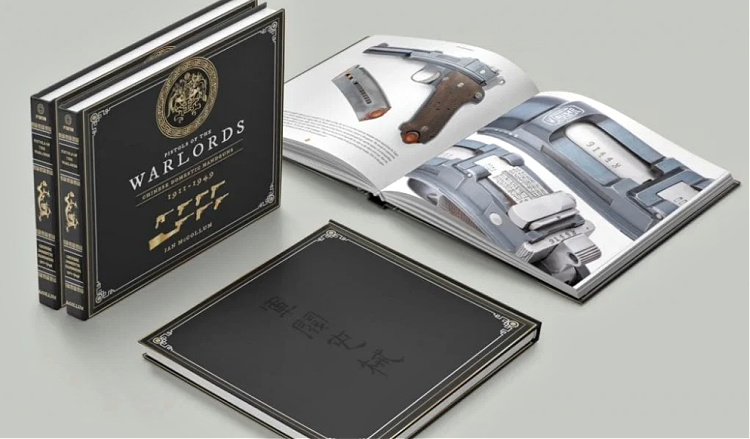
From the Head Stamp Publishing website:
Pistols of the Warlords: Chinese Domestic Handguns 1911 – 1949 is an exploration of the fascinating world of handgun production during the Chinese Warlord Era. This was a unique period in small arms history, exemplified by a multitude of truly unique handguns made individually by craftsman artisans. Long recognized as curiosities in the firearms world, this book presents the first organized study of these pistols ever to be published. Based on the close examination of several hundred examples from three major collections, it is a groundbreaking work that brings a brand new level of clarity to the identification of these arms. The book is divided into five main sections:
- Introduction and historical context
- Domestic Chinese designs
- C96 Mauser copies
- FN 1900 copies
- Copies of other Western designs
Gun history books like this one are a good addition to any library whether you own five books or five hundred. This is a picture-heavy book (which is excellent) and clearly, an enormous amount of work went into it. Check out the video to find out more about “Pistols of the Warlords” and why its contents might interest you as a gun owner.



Pingback: The Heat Vest From Forgotten Weapons - The Mag Life()
Pingback: The Heat Vest From Forgotten Weapons – Hunting USA()
Pingback: “Pistols of the Warlords” by Ian McCollum – Guns and Pride()